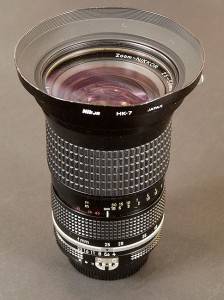
I had a lot of different lenses over the years. For the most part, they were the excellent, reliable, well-built Nikkor lenses made by Nikon. Some of them wore out, and I sold the rest of the manual focus Nikkors when I made the transition to digital. Most of my Nikkors were bought out of the necessity of my work; big, heavy, expensive pro lenses that took a beating in my daily imaging, but kept on making the light go where it should. Some I bought because I thought they would better suit my “fine art” pursuits, which for me meant outdoor photography. Often I would find these fine art lenses covered with dust on a shelf in a used camera store or pawn shop.

Sometimes we in the photographic community would hear about, or read about, lenses that were special and spectacular, but we would never actually see them in the field. One such lens was the incredible 25-50mm f/4 Nikkor, which appeared in the Nikon lens brochures for a few years during the time I was forming my opinions about photography, college. I and my friends had lots of the standard wide angle focal lengths of the era; a 24mm, a 28mm, a 35mm. For two periods in my history I had a 20mm, first the f/3.5 model, and later the f/2.8. Unlike today, in the 1970s and early 1980s, zooms were fairly rare. Nikon only sold about five different zooms, and they tended to be heavy and have small maximum apertures. But by the early 1980s, many of the early failures of zoom optics had been fixed, and the offerings, including the 25-50mm, were very fine lenses.
In use in the field, this zoom had a couple of advantages: the maximum aperture stayed constant at all zoom settings, and the lens was sharp at all apertures and shutter speeds. It was a “two-touch” zoom, meaning it had a separate zoom ring and focus ring. The focus “throw,” the distance the ring turned from infinity to the closest focus distance of about 2 feet, was huge, and as a result, the lens didn’t seem to “pop” into focus, and required a lot of rocking back and forth to find the sharpest point. Once you found the spot, though, it sang: sharp corner-to-corner, very little distortion (unlike today’s zooms), and even illumination even at f/4. I found myself at the 25mm end of the lens most of the time, but I did use the zoom as a compositional tool. I carried this lens in the desert, usually with a yellow filter on it for black-and-white imaging, often loaded with Kodak Panatomic-X film, rated at ISO 32. I was never disappointed in the image quality.
I take note of older lenses around me (one time at the Puye´Indian Ruins I correctly identified a woman’s 1969 Nikkormat as having come from Viet Nam), but I never saw another one of these in the field. I don’t see them on eBay any more, so I guess collectors are hiding them. I hope at least some of those wonderful lenses are making pictures today.

I use my 25-50 for product photography and as my wandering about lens – on a D2x – it’s as sharp as my 55 3.5 and 105 4.0 Micro Nikkors – and that’s saying something!